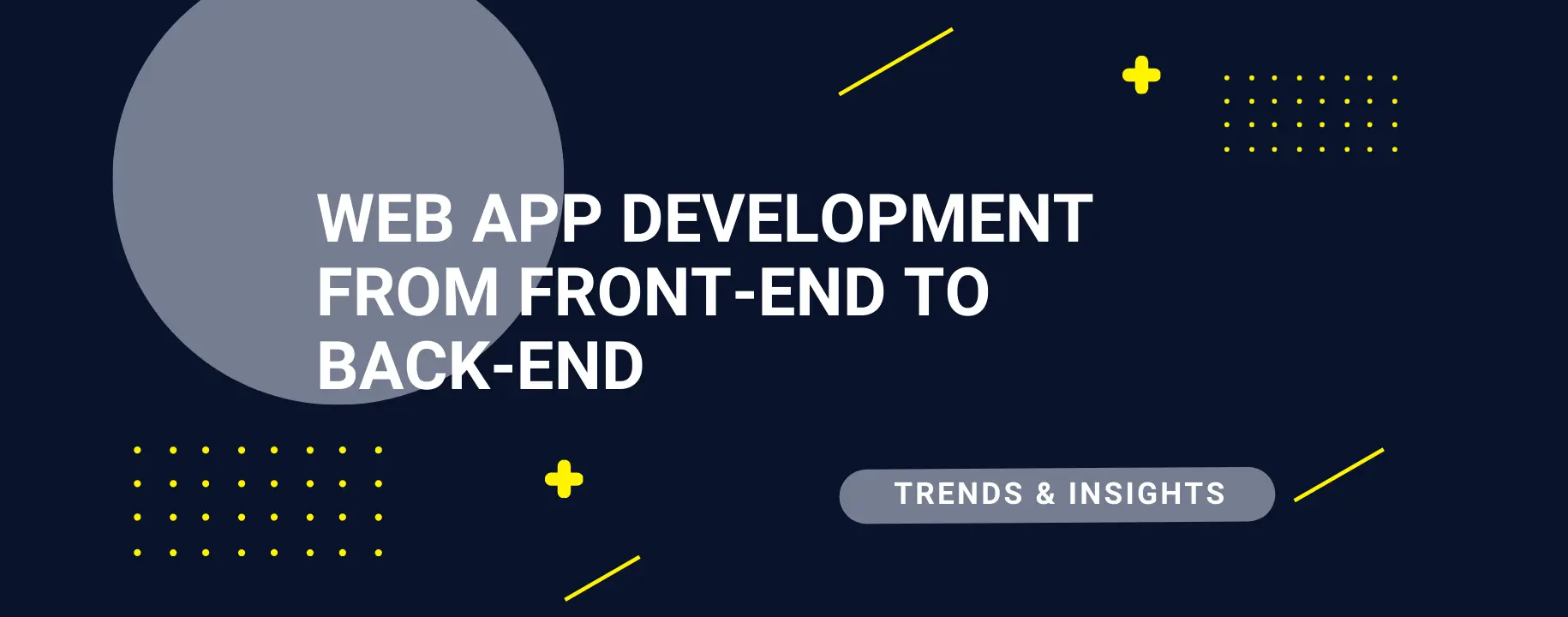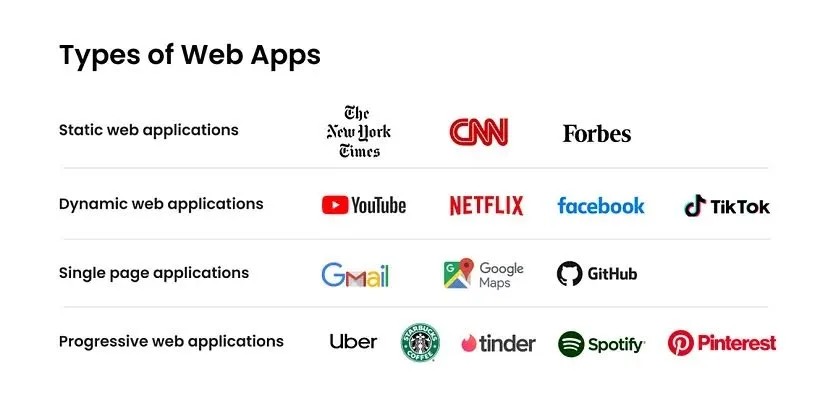- Product development
- 10 May 2024
Web app development: Learn easy & quick – a complete GUIDE
Web app development

Table of contents
Contributors

Some intro
Revenue in the Application Development Software market is projected to reach US$179.90 billion in 2024, according to Statista. This rapid growth underscores the increasing demand for web applications and the critical role they play in today’s digital landscape.
In this comprehensive guide, we’ll explore the fundamentals of web app development, providing you with easy and quick methods to build powerful and efficient web applications.
Whether you’re a beginner or looking to enhance your skills, this guide will equip you with the knowledge and tools needed to succeed in the dynamic field of website and app development.
Web app development lifecycle – process at BEECODED
Here is our process when it comes to web app development. BEECODED applies its expertise to master the process through seven stages: Planning and Requirement Gathering, Design, Development, Testing and Quality Assurance, Deployment, and Maintenance.
Understanding your web app vision
Our process begins with a deep dive into your web app goals and existing framework, laying the foundation for a meticulously planned project that addresses both user expectations and business objectives.
Collaborative sprint planning
Moving forward, we transition into the sprint phase, collaborating closely with you to outline each step of the development process. Through daily interactions and proactive communication, we ensure alignment and promptly address any emerging challenges to keep your web app project on track.
Thorough testing and deployment
As we progress through the sprint phase, we conduct comprehensive review sessions and plan for the testing and deployment stages. Our commitment to quality is unwavering, with rigorous testing procedures in place to ensure your web app meets the highest standards before launch.
Long-term support and optimization
Beyond deployment, our involvement doesn’t end. Our dedicated maintenance and support teams remain actively engaged, ensuring the continued smooth operation and optimization of your web app. We are committed to long-term success, constantly seeking opportunities for refinement and enhancement through ongoing updates and improvements.
Web application development frameworks
Now, let’s have a look into web app development frameworks. These are tools and libraries that help you build web applications more efficiently. Think of them as pre-built structures or templates that handle common tasks, so you don’t have to start from scratch every time.
 Source: https://sandra-parker.medium.com/a-detailed-guide-to-web-application-development-everything-you-need-to-know-e9001cd0b4f7
Source: https://sandra-parker.medium.com/a-detailed-guide-to-web-application-development-everything-you-need-to-know-e9001cd0b4f7
Web application development frameworks provide you with a solid foundation, including pre-written code for user interfaces, data management, and server communication. Popular ones include React, Angular, and Vue for the frontend, and Node.js, Django, and Ruby on Rails for the backend. Using these frameworks can save you a lot of time and help you follow best practices, making your development process smoother and faster. And now, how about a detailed story about them?
React: native web apps
- Imagine you’re working on a complex web app and need a way to efficiently manage your user interface. That’s where React comes in the native web apps. Created by Facebook, React is a JavaScript library for building dynamic user interfaces. It allows you to break down your UI into reusable components, making your code more organized and easier to manage. React’s virtual DOM makes updates super fast, so users get a smooth, responsive experience.
Angular
- Now, let’s talk about Angular. Developed by Google, Angular is a full-fledged framework for building robust web applications. It’s particularly strong when it comes to developing single-page applications (SPAs). Angular provides a lot of built-in features, like data binding, dependency injection, and comprehensive testing tools. It’s great for large-scale applications where you need a lot of structure and consistency.
Vue
- Next up is Vue, a progressive JavaScript framework that’s gained a lot of popularity for its simplicity and flexibility. Vue is designed to be incrementally adoptable, meaning you can use as much or as little of it as you need. It’s perfect for adding interactivity to existing projects or building complex SPAs from scratch. Vue’s gentle learning curve and comprehensive documentation make it a favorite among developers who want to get up and running quickly.
Node.js
- Switching to the backend, let’s look at Node.js. This runtime environment allows you to run JavaScript on the server side. Node.js is known for its non-blocking, event-driven architecture, which makes it perfect for handling multiple simultaneous connections efficiently. If you’re building real-time applications like chat apps or online gaming platforms, Node.js is a great choice because it’s fast and scalable.
Django – web app with Python
- For those who prefer web app with Python, there’s Django. This high-level web framework encourages rapid development and clean, pragmatic design. Django comes with a lot of built-in features like an ORM (Object-Relational Mapping), authentication, and an admin interface. It’s known for its “batteries-included” philosophy, meaning it provides a lot of functionality out of the box, so you can focus on building your app without worrying about the basics.
Ruby on Rails
- Lastly, we have Ruby on Rails, often just called Rails. This is a server-side web application framework written in Ruby. Rails follows the convention over configuration (CoC) and don’t repeat yourself (DRY) principles, which means it makes a lot of decisions for you and encourages reusable, concise code. Rails is great for getting a web app up and running quickly, with lots of tools and libraries to help you along the way.
Web apps vs websites
Let’s break down the difference between web apps and websites.
Websites
Think of a website as a collection of static pages you visit to get information. They’re usually informative and don’t require much interaction. For example, a blog, a news site, or a company’s homepage are typical websites. They might have some interactive elements, like forms or embedded videos, but the primary purpose is to provide content for users to read or view.
Web Apps
Now, web apps are more dynamic and interactive. They’re designed for user engagement and perform specific tasks. For instance, email services like Gmail, social media platforms like Facebook, and online banking portals are all web apps. They require user input and often allow you to create, read, update, or delete data directly within the app.
Key differences: web and app development
1. Interactivity: websites are mostly about displaying information, while web apps are about user interaction.
2. Functionality: web apps offer more complex functionalities, like user authentication, data processing, and real-time updates.
3. Development complexity: developing web apps usually requires more advanced programming and frameworks compared to websites.
4. Performance: web apps need to be optimized for performance since they handle more user interactions and data processing.
5. Updates: web apps often need regular updates to add features and improve security, whereas websites may remain unchanged for longer periods.
Web apps vs mobile apps: website and app development
Web apps are accessed through your web browser. You don’t need to download or install them. Examples include Google Docs and Trello.
Pros
- Cross-platform: they work on any device with a browser.
- No installation is needed: you can start using them immediately without downloading them.
- Easy updates: updates are automatic and don’t require user action.
Cons
- Internet required: they need an internet connection to work.
- Performance: they can be slower and less responsive compared to mobile apps.
- Limited device access: they can’t fully use device features like the camera or GPS.
Mobile apps are downloaded and installed from app stores (like Google Play or the Apple App Store). They’re designed specifically for mobile devices.
Pros
- Better performance: they’re faster and more responsive because they’re optimized for the device.
- Offline use: many mobile apps can work without an internet connection.
- Full device access: they can use all the features of the device, like the camera, GPS, and notifications.
Cons
- Platform-specific: separate versions are needed for iOS and Android.
- Installation required: users need to download and install them.
- Manual updates: users have to update apps through the app store.
Key differences – website and app development
- Web apps run in browsers; mobile apps are installed on devices.
- Mobile apps are usually faster and more integrated with device features.
- Web apps use web technologies (HTML, CSS, JavaScript); mobile apps need platform-specific development (Swift for iOS, Java/Kotlin for Android).
- Mobile apps often provide a more seamless experience because they’re designed specifically for the device.
Web app development cost
“How much does it cost to make a web app?” is a good question. When it comes to web app development, the cost can vary widely depending on several factors. Firstly, the complexity of the web application plays a significant role. Basic web apps with standard features like user authentication and simple data management may cost less, typically ranging from €20 to €60 per hour.
However, more complex web apps with advanced functionalities such as real-time updates, extensive database management, and complex user interfaces can cost significantly more, ranging from €50 to €150 per hour or even higher.
 Source: https://www.linkedin.com/pulse/how-much-does-cost-web-application-development-2024-guru-technolabs-dttrf/
Source: https://www.linkedin.com/pulse/how-much-does-cost-web-application-development-2024-guru-technolabs-dttrf/
Another factor influencing the cost is the technology stack chosen for development. Different technologies and frameworks come with varying hourly rates for developers. For instance, using popular frameworks like React.js or Angular may come with higher hourly rates due to their complexity and demand in the market. On the other hand, simpler frameworks or languages, like PHP, may result in lower hourly rates.
The geographical location of the development team can impact costs. Developers based in regions with higher living costs, such as Western Europe or North America, tend to charge higher hourly rates compared to those in Eastern Europe or Asia.
Furthermore, the type of web application being developed also affects costs. For example, e-commerce platforms or social networking sites often require extensive features and scalability, leading to higher development costs. Conversely, simpler informational websites or blogs may incur lower expenses.
Overall, while hourly rates provide a basic understanding of costs, it’s essential to consider the specific requirements, technologies, and expertise needed for your web app project. Balancing cost with quality and functionality is crucial to achieving success in web app development.
FAQs about web app development
Here are some frequently asked questions about website and app development. We have some questions to respond to. Let’s have a look at what people are curious about when it comes to web app development frameworks.
- Which is the best way to plan the development of a web app?
Document the high-level requirements. In formal projects, detail these down to low-level requirements and create tasks from them. While not essential for personal projects, breaking tasks into short, manageable pieces can enhance progress. Wireframe the interface, document and diagram the architectural design, and visualize the database structure.
- Web development or mobile app development?
Choosing between web development and mobile app development depends on your goals and target audience. Web development is ideal for creating applications accessible from any device with a browser, offering broader reach and easier updates. Mobile app development, on the other hand, provides better performance, access to device features, and a more tailored user experience for smartphones and tablets. Consider your project’s specific needs and the preferences of your target users when deciding. You can read more about app development here.
- What is needed to run a web application?
To run a web application, you need a web browser like Google Chrome or Mozilla Firefox for users to access it. Behind the scenes, a web server hosts the application’s files and serves them upon request. Data is often stored in a database such as MySQL or MongoDB, and the application’s code is written in languages like HTML, CSS, JavaScript, and back-end languages like Python or PHP. Frameworks like React.js or Django can streamline
development. An internet connection is essential for both users and the server to communicate and access the application over the web.
- How are web apps coded?
Web apps are coded using front-end languages like HTML, CSS, and JavaScript for the user interface and back-end languages like Python, PHP, or Node.js for server-side logic. Frameworks and libraries streamline development, while databases like MySQL or MongoDB handle data storage.
- Which programming languages and frameworks are best suited for developing high-performance web applications?
Popular choices for building high-performance web applications include front-end frameworks like React.js, Angular, and Vue.js, coupled with back-end technologies such as Node.js, Django, or Laravel . These frameworks offer robust features, scalability, and efficient development workflows, making them preferred options for developers aiming to create powerful and responsive web applications.
Why develop a web app with BEECODED
Opting for web app development with BEECODED unlocks a streamlined, comprehensive approach to success. We start by deeply understanding your project goals, ensuring seamless alignment between user needs and business objectives. Throughout development, we prioritize agile collaboration, ensuring that your web app evolves dynamically to meet changing requirements.
Our rigorous testing and release management protocols guarantee a high-quality, secure product launch. Plus, with ongoing refinement and support, your web app stays ahead of the curve.
We value transparency and quality, and our clients confirm this through the testimonials we receive upon project completion. If you’re curious to learn more about our development process at BEECODED, we invite you to explore our Case Study section. For instance, our project for PRSNT involved developing an MVP application, which was achieved in less than a month. Want to learn more?
Latest blog posts
View all postsSaaS development vs. traditional software development: Key Differences

Diana
22 August 2024Digital product discovery process for product owners [Guide]

Diana
14 August 2024